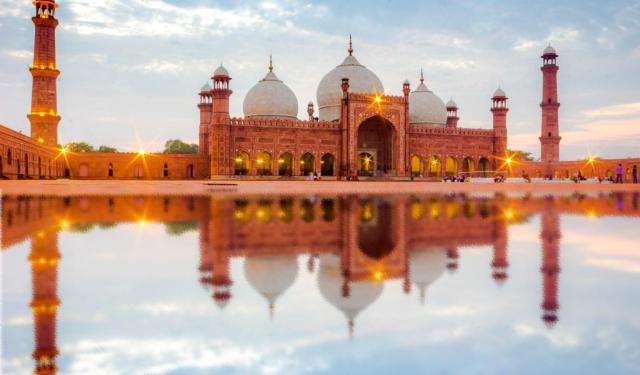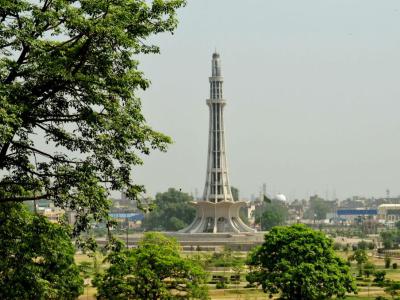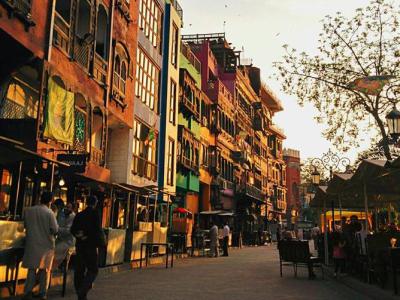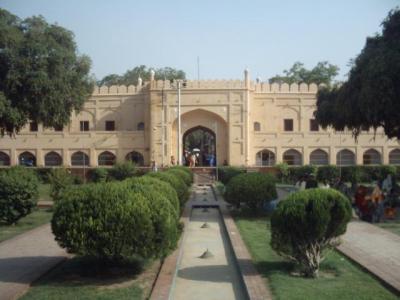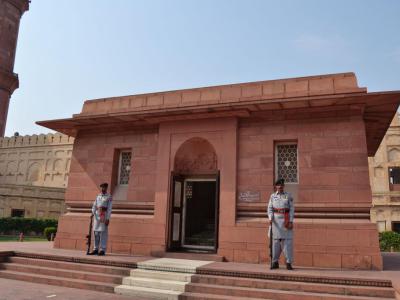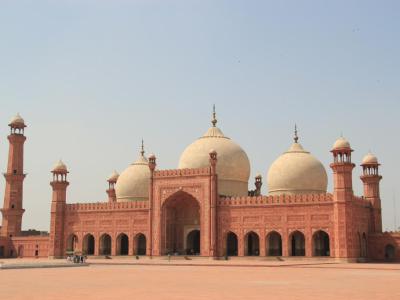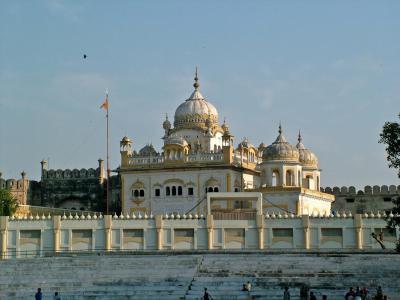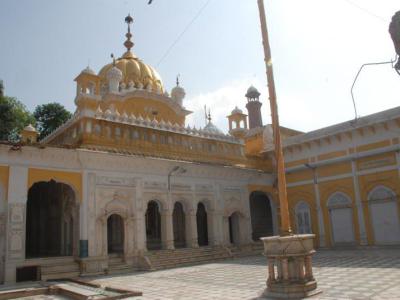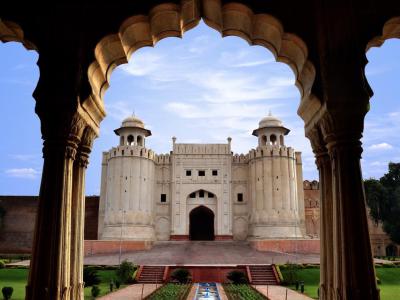Lahore Introduction Walking Tour (Self Guided), Lahore
"Lahore Lahore Hai." This popular Punjabi song (translating as "Lahore is Lahore") emphasizes the uniqueness and special character of this city, suggesting that there is no place quite like it. Also known as the "Pearl of the Punjab," Lahore is the second-largest city in Pakistan.
The name "Lahore" itself has a rather intriguing story. Some historians propose that it stems from "Ravāwar," possibly related to the Ravi River. Others attribute it to the word "Lohar," which means "blacksmith." Legend also traces its origin to Prince Lava, the son of Lord Rama and Sita, who founded the "City of Lava" ("Lavapuri").
Regardless of its origins, Lahore has been a center of civilization for over two millennia, during which it has witnessed the rise and fall of numerous empires. A prominent center during the Hindu Shahi, Ghaznavid, and Delhi Sultanate eras, Lahore reached its zenith under the Mughal Empire's reign, from the late 16th to early 18th century, when it was among the world's largest cities. However, in 1739, Nader Shah captured it, leading to a period of decline and conflict with the Afghans and Sikhs.
In the 19th century, Lahore regained importance as the capital of the Sikh Empire before becoming part of British Punjab in 1849. It played a pivotal role in both India's and Pakistan's independence movements, witnessing significant events like the declaration of Indian Independence and the resolution for Pakistan's establishment. The city also endured violence during the Partition period.
One of Lahore's most iconic landmarks is the Tower of Pakistan (Minar-e-Pakistan), a symbol of the country's independence, commemorating the historic Lahore Resolution of 1940.
Food lovers will rejoice at the mention of Fort Road Food Street, a culinary haven where you can savor delectable Pakistani cuisine while immersed in the city's vibrant atmosphere.
Lahore is also home to the Tomb of Allama Iqbal, a revered poet and philosopher, and the Hazuri Bagh Garden, an exquisite Mughal-era garden surrounding the majestic Badshahi Mosque.
The Lahore Fort, a UNESCO World Heritage site, is a magnificent complex that encompasses centuries of history within its walls.
A captivating metropolis, Lahore has played a pivotal role in the annals of South Asian history for centuries. Today, the city welcomes its guests with open arms, ready to share its rich heritage and warm hospitality. Come and experience the magic of Lahore for yourself on this self-guided walk. You will love it!
The name "Lahore" itself has a rather intriguing story. Some historians propose that it stems from "Ravāwar," possibly related to the Ravi River. Others attribute it to the word "Lohar," which means "blacksmith." Legend also traces its origin to Prince Lava, the son of Lord Rama and Sita, who founded the "City of Lava" ("Lavapuri").
Regardless of its origins, Lahore has been a center of civilization for over two millennia, during which it has witnessed the rise and fall of numerous empires. A prominent center during the Hindu Shahi, Ghaznavid, and Delhi Sultanate eras, Lahore reached its zenith under the Mughal Empire's reign, from the late 16th to early 18th century, when it was among the world's largest cities. However, in 1739, Nader Shah captured it, leading to a period of decline and conflict with the Afghans and Sikhs.
In the 19th century, Lahore regained importance as the capital of the Sikh Empire before becoming part of British Punjab in 1849. It played a pivotal role in both India's and Pakistan's independence movements, witnessing significant events like the declaration of Indian Independence and the resolution for Pakistan's establishment. The city also endured violence during the Partition period.
One of Lahore's most iconic landmarks is the Tower of Pakistan (Minar-e-Pakistan), a symbol of the country's independence, commemorating the historic Lahore Resolution of 1940.
Food lovers will rejoice at the mention of Fort Road Food Street, a culinary haven where you can savor delectable Pakistani cuisine while immersed in the city's vibrant atmosphere.
Lahore is also home to the Tomb of Allama Iqbal, a revered poet and philosopher, and the Hazuri Bagh Garden, an exquisite Mughal-era garden surrounding the majestic Badshahi Mosque.
The Lahore Fort, a UNESCO World Heritage site, is a magnificent complex that encompasses centuries of history within its walls.
A captivating metropolis, Lahore has played a pivotal role in the annals of South Asian history for centuries. Today, the city welcomes its guests with open arms, ready to share its rich heritage and warm hospitality. Come and experience the magic of Lahore for yourself on this self-guided walk. You will love it!
How it works: Download the app "GPSmyCity: Walks in 1K+ Cities" from Apple App Store or Google Play Store to your mobile phone or tablet. The app turns your mobile device into a personal tour guide and its built-in GPS navigation functions guide you from one tour stop to next. The app works offline, so no data plan is needed when traveling abroad.
Lahore Introduction Walking Tour Map
Guide Name: Lahore Introduction Walking Tour
Guide Location: Pakistan » Lahore (See other walking tours in Lahore)
Guide Type: Self-guided Walking Tour (Sightseeing)
# of Attractions: 9
Tour Duration: 2 Hour(s)
Travel Distance: 2.8 Km or 1.7 Miles
Author: DanaOffice
Sight(s) Featured in This Guide:
Guide Location: Pakistan » Lahore (See other walking tours in Lahore)
Guide Type: Self-guided Walking Tour (Sightseeing)
# of Attractions: 9
Tour Duration: 2 Hour(s)
Travel Distance: 2.8 Km or 1.7 Miles
Author: DanaOffice
Sight(s) Featured in This Guide:
- Minar-e-Pakistan (Tower of Pakistan)
- Fort Road Food Street
- Roshnai Gate (Gate of Lights)
- Tomb of Allama Iqbal
- Hazuri Bagh Garden
- Badshahi Mosque
- Samadhi of Ranjit Singh
- Gurdwara Dera Sahib
- Lahore Fort
1) Minar-e-Pakistan (Tower of Pakistan)
Minar-e-Pakistan, meaning "Tower of Pakistan," is an iconic monument located in Lahore. This striking tower stands as a symbol of the nation's history and aspirations. It was constructed between 1960 and 1968 on the historic site where the All-India Muslim League passed the Lahore Resolution on 23 March 1940. This resolution, later known as the Pakistan Resolution, marked the formal call for a separate and independent homeland for the Muslims of British India, a pivotal moment driven by the two-nation theory. Eventually, this resolution played a crucial role in the creation of Pakistan in 1947.
Situated within the picturesque Greater Iqbal Park in the heart of Lahore, Minar-e-Pakistan beautifully combines elements of both Mughal/Islamic and modern architectural styles. The tower's design and supervision were overseen by Nasreddin Murat-Khan, a distinguished Russian-born Pakistani architect and civil engineer. The minaret not only serves as a historical symbol but also offers visitors a panoramic view of its surroundings. To reach the top, visitors can ascend via a staircase or opt for the convenience of an elevator.
The base of the tower is thoughtfully designed in the shape of a flower, adding to its visual appeal. The monument's surroundings are adorned with lush parks and vibrant flowers, creating a serene and inviting atmosphere. The site is frequently used for political and religious events and is often referred to as the "Liberty Tower of Pakistan." Minar-e-Pakistan stands as a testament to the nation's enduring spirit and its journey towards independence and sovereignty.
Situated within the picturesque Greater Iqbal Park in the heart of Lahore, Minar-e-Pakistan beautifully combines elements of both Mughal/Islamic and modern architectural styles. The tower's design and supervision were overseen by Nasreddin Murat-Khan, a distinguished Russian-born Pakistani architect and civil engineer. The minaret not only serves as a historical symbol but also offers visitors a panoramic view of its surroundings. To reach the top, visitors can ascend via a staircase or opt for the convenience of an elevator.
The base of the tower is thoughtfully designed in the shape of a flower, adding to its visual appeal. The monument's surroundings are adorned with lush parks and vibrant flowers, creating a serene and inviting atmosphere. The site is frequently used for political and religious events and is often referred to as the "Liberty Tower of Pakistan." Minar-e-Pakistan stands as a testament to the nation's enduring spirit and its journey towards independence and sovereignty.
2) Fort Road Food Street (must see)
Less than a 5-minute stroll from the iconic Badshahi Mosque lies the enchanting Fort Road Food Street. This vibrant culinary haven is a delightful blend of delicious Lahori cuisine and mesmerizing architecture. As you explore this bustling food street, you'll be captivated by the intricate details adorning the colorful buildings, each revealing something new with every glance.
The Fort Road Food Street, nestled between Fort Road and Roshnai Gate of the Walled City, was meticulously reconstructed and opened in 2012 to beckon tourists and locals alike. It offers a tantalizing array of Lahori dishes amidst the backdrop of the magnificent Badshahi Mosque. This culinary destination was inaugurated on 21st January 2012 by Hamza Shahbaz Sharif, replacing the former Gawalmandi Food Street. Today, the Fort Road Food Street stands as a testament to both the Mughal Empire and British Rule, as it inhabits a building that carries the legacy of these historic eras.
What truly sets this food street apart is its unique offering-traditional Lahori cuisine complemented by an enchanting view of the Badshahi Mosque. Several restaurants along this bustling street provide patrons with a spectacular vantage point to admire the grandeur of the Badshahi Mosque. For an unforgettable experience, consider visiting just before sunset. As you savor the delectable local dishes, you'll be treated to a breathtaking view of the sun setting over the Badshahi Mosque, creating a memory that lingers as a testament to the rich culture and flavors of Lahore.
The Fort Road Food Street, nestled between Fort Road and Roshnai Gate of the Walled City, was meticulously reconstructed and opened in 2012 to beckon tourists and locals alike. It offers a tantalizing array of Lahori dishes amidst the backdrop of the magnificent Badshahi Mosque. This culinary destination was inaugurated on 21st January 2012 by Hamza Shahbaz Sharif, replacing the former Gawalmandi Food Street. Today, the Fort Road Food Street stands as a testament to both the Mughal Empire and British Rule, as it inhabits a building that carries the legacy of these historic eras.
What truly sets this food street apart is its unique offering-traditional Lahori cuisine complemented by an enchanting view of the Badshahi Mosque. Several restaurants along this bustling street provide patrons with a spectacular vantage point to admire the grandeur of the Badshahi Mosque. For an unforgettable experience, consider visiting just before sunset. As you savor the delectable local dishes, you'll be treated to a breathtaking view of the sun setting over the Badshahi Mosque, creating a memory that lingers as a testament to the rich culture and flavors of Lahore.
3) Roshnai Gate (Gate of Lights)
The Gate of Lights is a historic gateway located within the confines of the Walled City. This gate holds a significant place in the city's history and architecture, having served as the primary entry point for emperors and nobles during the Mughal era and later during the Sikh period.
What sets Roshnai Gate apart is its impressive size and structure, which bears witness to its use as the main entry for royal caravans, including those with majestic elephants. In the days of the Mughal Empire, the gate held a special importance due to its proximity to the Ravi River, which once flowed alongside the northern walls of the Lahore Fort and the Badshahi Mosque. To facilitate the passage of travelers and to create a striking visual spectacle, the gate was adorned with elaborate lighting, illuminating the night sky. It is this radiant quality that earned the gate its name, "Roshnai Darwaza" or the "gate of light."
What distinguishes Roshnai Gate is its unique status as the oldest gate in Lahore that has been meticulously preserved in its original architectural form. This preservation allows visitors to step back in time and experience the grandeur and magnificence that once marked Lahore's royal entryways.
What sets Roshnai Gate apart is its impressive size and structure, which bears witness to its use as the main entry for royal caravans, including those with majestic elephants. In the days of the Mughal Empire, the gate held a special importance due to its proximity to the Ravi River, which once flowed alongside the northern walls of the Lahore Fort and the Badshahi Mosque. To facilitate the passage of travelers and to create a striking visual spectacle, the gate was adorned with elaborate lighting, illuminating the night sky. It is this radiant quality that earned the gate its name, "Roshnai Darwaza" or the "gate of light."
What distinguishes Roshnai Gate is its unique status as the oldest gate in Lahore that has been meticulously preserved in its original architectural form. This preservation allows visitors to step back in time and experience the grandeur and magnificence that once marked Lahore's royal entryways.
4) Tomb of Allama Iqbal
The Tomb of Allama Iqbal serves as the final resting place of Muhammad Iqbal, the national poet of Pakistan. Designed in the distinctive Mughal architectural style, this mausoleum is situated adjacent to the magnificent walls of the historic Badshahi Mosque within the enchanting Hazuri Bagh garden.
Muhammad Iqbal, affectionately known as Muffakir-e-Pakistan (The Thinker of Pakistan) and Shair-e-Mashriq (The Poet of the East), was a prominent inspiration behind the Pakistan Movement. He passed away on 21 April 1938 in Lahore at the age of 60, leaving an indelible mark on the nation's history and identity. The Tomb of Allama Iqbal has since become a place of pilgrimage for thousands of visitors who come daily to pay their respects to the poet-philosopher.
The architectural style of the mausoleum is a harmonious blend of various influences, primarily reflecting the grandeur of Mughal architecture. Constructed entirely from red sandstone, which was sourced from Jaipur in British India, and adorned with marble from Makrana, Rajputana, the structure boasts a timeless appeal. However, construction faced delays after Pakistan's independence in 1947 due to export restrictions on red stone from India.
Inside the mausoleum, six couplets of a ghazal from Iqbal's poetic work, Zabur-e-Ajam (Persian Psalms), are intricately carved on the interior surfaces, adding to the artistic allure. Outside, a small garden surrounds the tomb, divided into neatly arranged plots. The mausoleum's design was masterminded by Nawab Zain Yar Jang Bahadur, then Chief Architect of Hyderabad Deccan. Its construction spanned thirteen years and cost approximately one hundred thousand Pakistani rupees. The main cause for the delay was the interruption in the supply of red stone from Jaipur, India, following independence.
The rectangular mausoleum features two elaborately designed gates, one at the eastern entrance and the other at the southern side, embellished with marble. The cenotaph itself is sculpted from white marble and stands as a remarkable centerpiece. An exceptional tombstone, gifted by the people of Afghanistan, is crafted from lapis lazuli and intricately inscribed with Quranic verses in elegant calligraphy, a treasure from Afghanistan's cultural heritage.
Muhammad Iqbal, affectionately known as Muffakir-e-Pakistan (The Thinker of Pakistan) and Shair-e-Mashriq (The Poet of the East), was a prominent inspiration behind the Pakistan Movement. He passed away on 21 April 1938 in Lahore at the age of 60, leaving an indelible mark on the nation's history and identity. The Tomb of Allama Iqbal has since become a place of pilgrimage for thousands of visitors who come daily to pay their respects to the poet-philosopher.
The architectural style of the mausoleum is a harmonious blend of various influences, primarily reflecting the grandeur of Mughal architecture. Constructed entirely from red sandstone, which was sourced from Jaipur in British India, and adorned with marble from Makrana, Rajputana, the structure boasts a timeless appeal. However, construction faced delays after Pakistan's independence in 1947 due to export restrictions on red stone from India.
Inside the mausoleum, six couplets of a ghazal from Iqbal's poetic work, Zabur-e-Ajam (Persian Psalms), are intricately carved on the interior surfaces, adding to the artistic allure. Outside, a small garden surrounds the tomb, divided into neatly arranged plots. The mausoleum's design was masterminded by Nawab Zain Yar Jang Bahadur, then Chief Architect of Hyderabad Deccan. Its construction spanned thirteen years and cost approximately one hundred thousand Pakistani rupees. The main cause for the delay was the interruption in the supply of red stone from Jaipur, India, following independence.
The rectangular mausoleum features two elaborately designed gates, one at the eastern entrance and the other at the southern side, embellished with marble. The cenotaph itself is sculpted from white marble and stands as a remarkable centerpiece. An exceptional tombstone, gifted by the people of Afghanistan, is crafted from lapis lazuli and intricately inscribed with Quranic verses in elegant calligraphy, a treasure from Afghanistan's cultural heritage.
5) Hazuri Bagh Garden
Hazuri Bagh is a splendid garden that boasts an illustrious history and captivating surroundings. This enchanting oasis is bound by the grand Lahore Fort to the east, the majestic Badshahi Mosque to the west, the revered Samadhi of Ranjit Singh to the north, and the elegant Roshnai Gate to the south. Hazuri Bagh is not just a garden; it's a place where history, architecture, and nature converge in perfect harmony.
The story of Hazuri Bagh dates back to the era of Maharaja Ranjit Singh, a prominent ruler of the Sikh Empire. During his reign, this beautiful garden was meticulously crafted in the style reminiscent of Mughal gardens, reflecting the grandeur and opulence of that era. At its heart lies the Hazuri Bagh Baradari, a stunning pavilion erected by Maharaja Ranjit Singh himself in 1818 to commemorate his triumphant acquisition of the legendary Koh-i-Noor diamond from Shuja Shah Durrani in 1813.
The garden's layout and design were meticulously planned under the watchful eye of Faqir Azizuddin, following the traditional Mughal style. Interestingly, it is said that at the suggestion of Jamadar Khushhal Singh, Ranjit Singh ordered the extraction of marble from various mausoleums in Lahore to construct the elegant baradari in Hazuri Bagh.
Every Sunday afternoon, Hazuri Bagh comes alive with the melodious recitations of traditional Punjabi Qisse, including tales like Heer Ranjha and Sassi Punnun, as well as other Punjabi Sufi poetry. People gather here to immerse themselves in the rich cultural heritage and timeless stories that echo through the ages.
The story of Hazuri Bagh dates back to the era of Maharaja Ranjit Singh, a prominent ruler of the Sikh Empire. During his reign, this beautiful garden was meticulously crafted in the style reminiscent of Mughal gardens, reflecting the grandeur and opulence of that era. At its heart lies the Hazuri Bagh Baradari, a stunning pavilion erected by Maharaja Ranjit Singh himself in 1818 to commemorate his triumphant acquisition of the legendary Koh-i-Noor diamond from Shuja Shah Durrani in 1813.
The garden's layout and design were meticulously planned under the watchful eye of Faqir Azizuddin, following the traditional Mughal style. Interestingly, it is said that at the suggestion of Jamadar Khushhal Singh, Ranjit Singh ordered the extraction of marble from various mausoleums in Lahore to construct the elegant baradari in Hazuri Bagh.
Every Sunday afternoon, Hazuri Bagh comes alive with the melodious recitations of traditional Punjabi Qisse, including tales like Heer Ranjha and Sassi Punnun, as well as other Punjabi Sufi poetry. People gather here to immerse themselves in the rich cultural heritage and timeless stories that echo through the ages.
6) Badshahi Mosque (must see)
The Badshahi Mosque is a magnificent architectural masterpiece that stands as a symbol of the glorious Mughal Empire (1526-1857). This historic mosque, built in the year 1671, is often regarded as one of the most beautiful and iconic landmarks in Pakistan. Its architectural splendor is characterized by the exquisite use of intricately carved red sandstone, which is a hallmark of the Mughal era.
One of the most striking features of the Badshahi Mosque is its vast courtyard, capable of accommodating an astounding 100,000 worshippers. This impressive space makes the Badshahi Mosque the second largest mosque in Pakistan, a testament to its grandeur. To truly appreciate the mosque's remarkable architectural details, it is recommended to spend several hours exploring its captivating design.
Throughout its history, the Badshahi Mosque has served various purposes. During the Sikh rule from 1799 to 1849, it was repurposed as a military base, with the courtyard even being used as stables for army horses. Subsequently, when the British took control of Lahore after the fall of the Sikh Empire, they continued to use the mosque for military purposes. It was not until 1947, when Pakistan gained its independence, that the Badshahi Mosque was rightfully restored to its original function as a place of worship and prayer.
One of the most striking features of the Badshahi Mosque is its vast courtyard, capable of accommodating an astounding 100,000 worshippers. This impressive space makes the Badshahi Mosque the second largest mosque in Pakistan, a testament to its grandeur. To truly appreciate the mosque's remarkable architectural details, it is recommended to spend several hours exploring its captivating design.
Throughout its history, the Badshahi Mosque has served various purposes. During the Sikh rule from 1799 to 1849, it was repurposed as a military base, with the courtyard even being used as stables for army horses. Subsequently, when the British took control of Lahore after the fall of the Sikh Empire, they continued to use the mosque for military purposes. It was not until 1947, when Pakistan gained its independence, that the Badshahi Mosque was rightfully restored to its original function as a place of worship and prayer.
7) Samadhi of Ranjit Singh
The Samadhi of Ranjit Singh, a 19th-century architectural masterpiece, stands as a tribute to the legacy of Sikh Maharaja Ranjit Singh (1780 – 1839). This historic monument holds the funerary urns of the revered Maharaja. Additionally, it shares its surroundings with the Gurdwara Dera Sahib, a place marking the spot where Guru Arjan Dev, the fifth guru of Sikhism, breathed his last.
The construction of this awe-inspiring structure commenced under the reign of Maharaja Kharak Singh, the son and successor of Ranjit Singh, following the Maharaja's passing in 1839. Nine years later, in 1848, the construction was completed under the supervision of his youngest son, Duleep Singh. The Samadhi overlooks the Hazuri Bagh, another splendid creation attributed to Ranjit Singh himself.
What makes the Samadhi of Ranjit Singh truly remarkable is its fusion of architectural styles, seamlessly blending elements from Sikh, Hindu, and Islamic traditions. The building boasts gilded fluted domes and cupolas, exuding an air of regal grandeur. Along the upper portion of the structure, an intricate and ornate balustrade adds to its visual appeal.
As you approach the entrance, the front doorway greets you with images of Ganesh, Devi, and Brahma, painstakingly carved from red sandstone. The central dome is adorned with unique Nāga (serpent) hood designs, a testament to the Hindu craftsmen who contributed their artistry to this project. Inside, the wooden panels of the ceiling are adorned with delicate stained glass work, while the walls are resplendent with intricate floral designs. The ceilings themselves are adorned with the exquisite artistry of glass mosaics.
At the heart of this sacred monument lies the resting place of Maharaja Ranjit Singh. His ashes are enshrined within a marble urn fashioned in the shape of a lotus. This urn is lovingly sheltered beneath a marble pavilion, a true masterpiece of pietra dura inlay work. Surrounding the Maharaja are smaller urns that contain the ashes of four Hindu sati queens and seven concubines, a testament to the rich cultural tapestry and harmonious coexistence of various traditions during that era.
The construction of this awe-inspiring structure commenced under the reign of Maharaja Kharak Singh, the son and successor of Ranjit Singh, following the Maharaja's passing in 1839. Nine years later, in 1848, the construction was completed under the supervision of his youngest son, Duleep Singh. The Samadhi overlooks the Hazuri Bagh, another splendid creation attributed to Ranjit Singh himself.
What makes the Samadhi of Ranjit Singh truly remarkable is its fusion of architectural styles, seamlessly blending elements from Sikh, Hindu, and Islamic traditions. The building boasts gilded fluted domes and cupolas, exuding an air of regal grandeur. Along the upper portion of the structure, an intricate and ornate balustrade adds to its visual appeal.
As you approach the entrance, the front doorway greets you with images of Ganesh, Devi, and Brahma, painstakingly carved from red sandstone. The central dome is adorned with unique Nāga (serpent) hood designs, a testament to the Hindu craftsmen who contributed their artistry to this project. Inside, the wooden panels of the ceiling are adorned with delicate stained glass work, while the walls are resplendent with intricate floral designs. The ceilings themselves are adorned with the exquisite artistry of glass mosaics.
At the heart of this sacred monument lies the resting place of Maharaja Ranjit Singh. His ashes are enshrined within a marble urn fashioned in the shape of a lotus. This urn is lovingly sheltered beneath a marble pavilion, a true masterpiece of pietra dura inlay work. Surrounding the Maharaja are smaller urns that contain the ashes of four Hindu sati queens and seven concubines, a testament to the rich cultural tapestry and harmonious coexistence of various traditions during that era.
8) Gurdwara Dera Sahib
Gurdwara Dera Sahib holds deep historical and religious significance in the Sikh faith. It stands as a poignant memorial to commemorate the martyrdom of Guru Arjan Dev, the 5th guru of Sikhism, who met his tragic fate at this very spot in the year 1606.
Guru Arjan Dev's ordeal unfolded on the orders of the Mughal emperor Jahangir, within the walls of Lahore's historic old city. The site of his torture is now remembered as the defunct Gurdwara Lal Khoohi, which has been repurposed into a Muslim shrine known as Haq Chaar Yaar. It was during this harrowing episode that the Guru's dear friend and Muslim mystic, Mian Mir, was deeply moved and distressed by the torment inflicted upon him.
After enduring five days of relentless torture, Guru Arjan Dev made a humble request to be allowed a bath in the river. This request was granted, thanks to Mian Mir's intervention. As the Guru submerged himself in the river, a profound and miraculous event occurred. He did not resurface, leaving those present in astonishment. Despite extensive efforts by a Mughal search party, Guru Arjan Dev could not be retrieved from the river.
In remembrance of this tragic event and the indomitable spirit of Guru Arjan Dev, his son and successor, Guru Hargobind, commissioned the construction of a memorial at this sacred site in 1619. The main Gurudwara building, featuring an exquisite gilded dome, was later erected during the reign of Maharaja Ranjit Singh. Over the years, additional modifications and enhancements were made, continuing the legacy of reverence and devotion to Guru Arjan Dev.
Gurdwara Dera Sahib serves as a hallowed place of worship and pilgrimage for Sikhs, drawing devotees from far and wide who come to pay their respects to Guru Arjan Dev. It is a testament to the enduring significance of his life, his teachings, and his profound sacrifice for the Sikh community.
Guru Arjan Dev's ordeal unfolded on the orders of the Mughal emperor Jahangir, within the walls of Lahore's historic old city. The site of his torture is now remembered as the defunct Gurdwara Lal Khoohi, which has been repurposed into a Muslim shrine known as Haq Chaar Yaar. It was during this harrowing episode that the Guru's dear friend and Muslim mystic, Mian Mir, was deeply moved and distressed by the torment inflicted upon him.
After enduring five days of relentless torture, Guru Arjan Dev made a humble request to be allowed a bath in the river. This request was granted, thanks to Mian Mir's intervention. As the Guru submerged himself in the river, a profound and miraculous event occurred. He did not resurface, leaving those present in astonishment. Despite extensive efforts by a Mughal search party, Guru Arjan Dev could not be retrieved from the river.
In remembrance of this tragic event and the indomitable spirit of Guru Arjan Dev, his son and successor, Guru Hargobind, commissioned the construction of a memorial at this sacred site in 1619. The main Gurudwara building, featuring an exquisite gilded dome, was later erected during the reign of Maharaja Ranjit Singh. Over the years, additional modifications and enhancements were made, continuing the legacy of reverence and devotion to Guru Arjan Dev.
Gurdwara Dera Sahib serves as a hallowed place of worship and pilgrimage for Sikhs, drawing devotees from far and wide who come to pay their respects to Guru Arjan Dev. It is a testament to the enduring significance of his life, his teachings, and his profound sacrifice for the Sikh community.
9) Lahore Fort (must see)
The Lahore Fort, known locally as the Royal Fort, is a historic citadel located in the vibrant city of Lahore. This magnificent fortress is situated at the northern end of the Walled City of Lahore and covers an expansive area of more than 20 hectares, equivalent to 49 acres. Within its imposing walls, the Lahore Fort houses a remarkable collection of 21 significant monuments, some of which trace their origins back to the reign of Emperor Akbar.
While the site of the Lahore Fort has been inhabited for countless millennia, the earliest known fortified structure at this location was an 11th-century mudbrick fort. However, the foundations of the Lahore Fort as we see it today were laid in 1566 during the reign of Emperor Akbar, a period when the Mughal Empire was at its zenith. Akbar's vision for the fort combined elements of Islamic and Hindu architectural styles, resulting in a unique and syncretic design.
The Lahore Fort is particularly renowned for its extensive reconstruction in the 17th century, during the height of the Mughal Empire's grandeur. Notable additions from this era include the opulent use of marble adorned with intricate Persian floral patterns. One of the fort's most iconic features, the Alamgiri Gate, was added by the great Mughal emperor Aurangzeb and faces the famous Badshahi Mosque, creating a stunning architectural ensemble.
In recognition of its exceptional historical and architectural significance, the Lahore Fort was inscribed as a UNESCO World Heritage Site in 1981. This designation acknowledges the fort's outstanding collection of Mughal monuments, dating from a period when the empire reached its zenith in terms of artistic and aesthetic achievements.
While the site of the Lahore Fort has been inhabited for countless millennia, the earliest known fortified structure at this location was an 11th-century mudbrick fort. However, the foundations of the Lahore Fort as we see it today were laid in 1566 during the reign of Emperor Akbar, a period when the Mughal Empire was at its zenith. Akbar's vision for the fort combined elements of Islamic and Hindu architectural styles, resulting in a unique and syncretic design.
The Lahore Fort is particularly renowned for its extensive reconstruction in the 17th century, during the height of the Mughal Empire's grandeur. Notable additions from this era include the opulent use of marble adorned with intricate Persian floral patterns. One of the fort's most iconic features, the Alamgiri Gate, was added by the great Mughal emperor Aurangzeb and faces the famous Badshahi Mosque, creating a stunning architectural ensemble.
In recognition of its exceptional historical and architectural significance, the Lahore Fort was inscribed as a UNESCO World Heritage Site in 1981. This designation acknowledges the fort's outstanding collection of Mughal monuments, dating from a period when the empire reached its zenith in terms of artistic and aesthetic achievements.
The Most Popular Cities
/ view all
